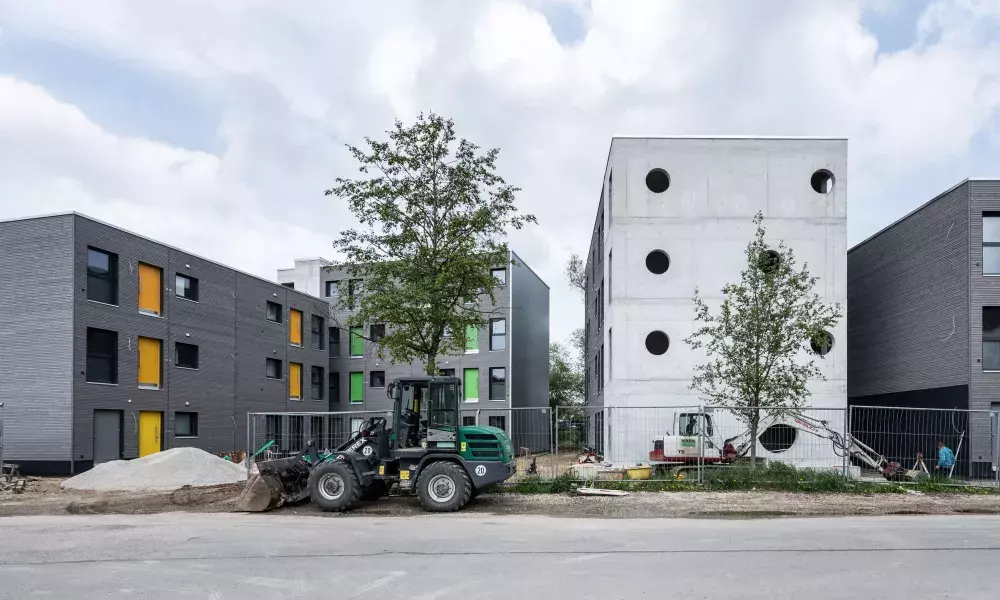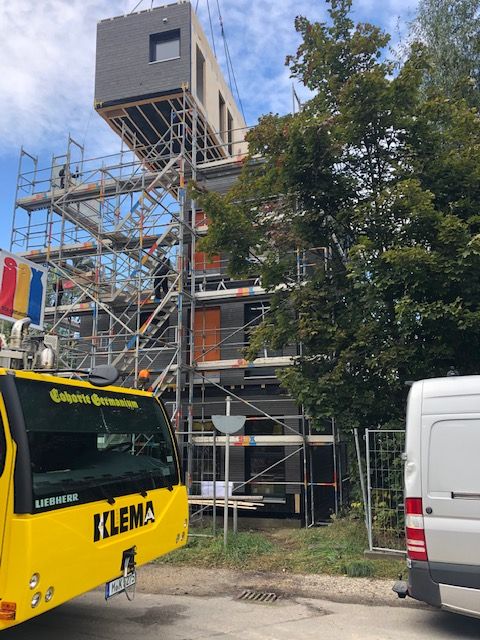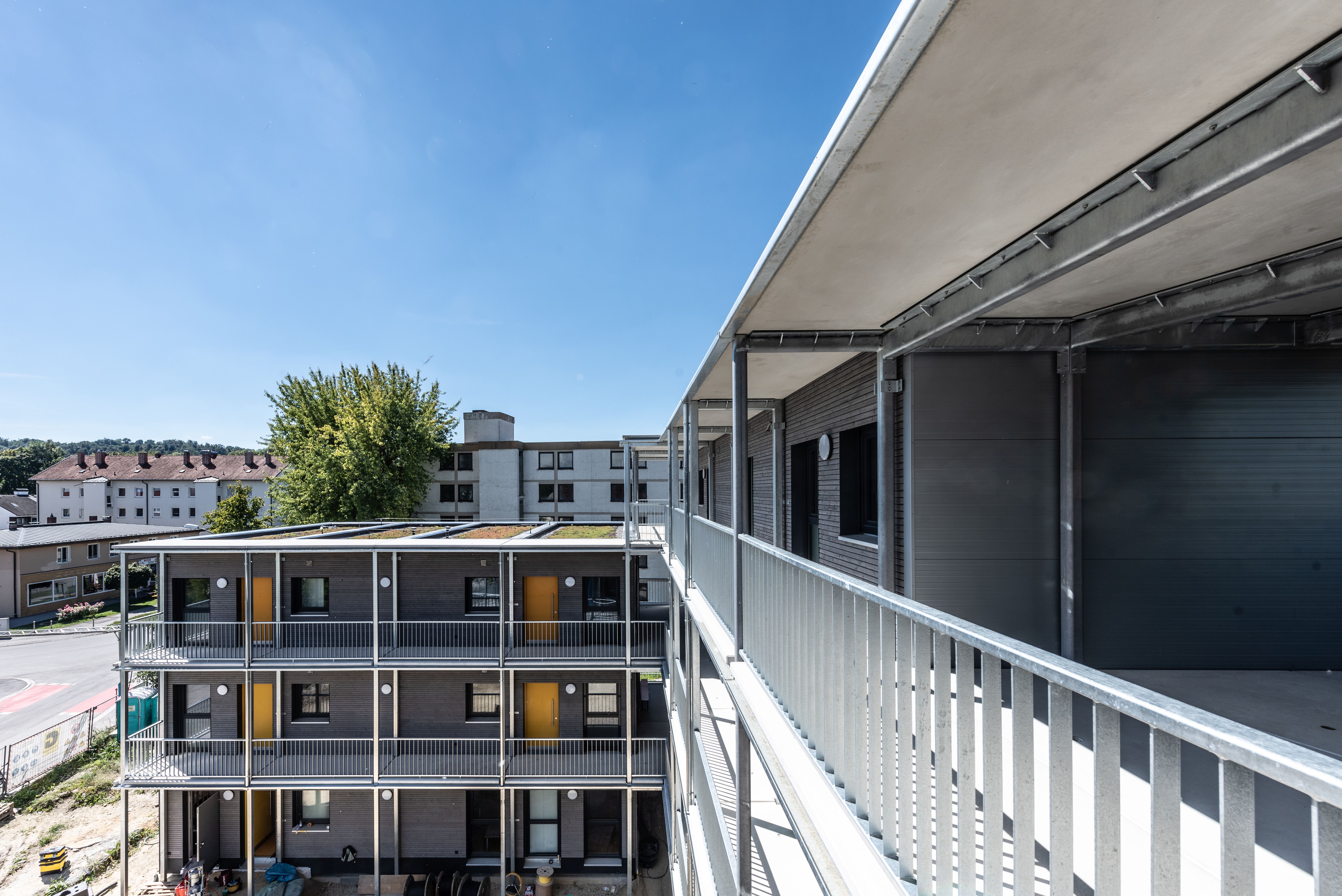The development of the new home concept in the UIA project combining housing with work and childcare

From the very beginning, the focus of the UIA project "home and care" of the city of Landshut was the construction of a house which combines housing and working. The project aims to address the needs of single mothers in particular who are in training or work in the care sector by enabling them to find a new home and at the same time also be able to use the childcare facilities in the new house. In the project, this is called the door-to-door concept, because childcare takes place “next door” on the ground floor of the shared building.
This web article discusses what can be learned from the development of the idea to the opening, and how the financing and ownership for sustainable use were defined.
1. The development of the building from the idea to the opening
The idea of the "next door concept" was a central part of the project application and had to be implemented as quickly as possible. It became rapidly clear that a general contractor had to be found due to the short construction period. Preferably a modular builder who could build regardless of weather conditions. However, the award guidelines stipulated that the services should be shared between the involved companies. Thus, at the end of 2019, with the help of a process supervisor, a general planner was put out to tender to find a temporary construction solution for the building site. All apartments and childcare facilities should be the same size and provide opportunities for residents to meet in common areas. The planning was successfully completed in the summer of 2020 and the building permit was issued. However, no general contractor could be found that would build the project building for an acceptable price. Thus, the city decided to issue separate tenders and to apply for an extension of the project implementation period.
The new public national tender for the general contractor without the external trades started in November 2020 via the platform "Deutsche eVergabe". There were six offers from timber module builders received with price differences of up to two million Euros, and all of them were again over the approved project budget. However, as the experienced lowest bidder promised a higher energy standard, the contract was awarded even if it was above the initial budget. Subsequently, the execution planning could start and the building construction and civil engineering trades were put out to tender. Three offers were received and the lowest bidder was again just over the budget, but was still awarded the contract to avoid jeopardizing th building completion. Finally, the metalwork was put out to tender and awarded in a national public procedure with six bids. The lowest bidder was awarded the contract despite being over the budget. Despite the higher costs, the approval was received from the Office of Finance and the City Council as the additional costs were secured from the municipal budget. An important milestone on the way to the building construction was thus reached.

In the summer of 2021, the “home and care” project celebrated the ground-breaking ceremony with a small group respecting the applicable pandemic conditions. Afterwards, the construction documentation of the modular buildings and the start of the work on the construction site, as well as the production of the modular buildings in the factory in Allgäu took place. Due to further corona cases in the companies and difficult conditions on the construction site, as the soil had to be disposed of in a complicated manner, it was unfortunately not possible to complete the modular construction on time at the end of 2021. Instead, this part of the construction dragged on until February 2022. In addition, there were difficulties in the procurement of steel. The structural requirements also increased and thus the construction costs too. Due to the delayed installation of the arcade and the underground lines that were not laid until after the module construction, there were also delays in the completion of electricity, water and heating. By taking temporary measures, however, the project was still able to ensure that childcare on the first floor started in September 2022 in time for the start of school and the first residents moved in. The last apartment was handed over in mid-October. It was a great success that the use of all housing and childcare spaces could start despite the encountered difficulties. However, the outdoor facilities such as the garden and lawn still have to wait. Completion is planned together with a public political inauguration ceremony in spring 2023.

The idea of the "next door concept" was a central part of the project application and had to be implemented as quickly as possible. It became rapidly clear that a general contractor had to be found due to the short construction period. Preferably a modular builder who could build regardless of weather conditions. However, the award guidelines stipulated that the services should be shared between the involved companies. Thus, at the end of 2019, with the help of a process supervisor, a general planner was put out to tender to find a temporary construction solution for the building site. All apartments and childcare facilities should be the same size and provide opportunities for residents to meet in common areas. The planning was successfully completed in the summer of 2020 and the building permit was issued. However, no general contractor could be found that would build the project building for an acceptable price. Thus, the city decided to issue separate tenders and to apply for an extension of the project implementation period.
The new public national tender for the general contractor without the external trades started in November 2020 via the platform "Deutsche eVergabe". There were six offers from timber module builders received with price differences of up to two million Euros, and all of them were again over the approved project budget. However, as the experienced lowest bidder promised a higher energy standard, the contract was awarded even if it was above the initial budget. Subsequently, the execution planning could start and the building construction and civil engineering trades were put out to tender. Three offers were received and the lowest bidder was again just over the budget, but was still awarded the contract to avoid jeopardizing th building completion. Finally, the metalwork was put out to tender and awarded in a national public procedure with six bids. The lowest bidder was awarded the contract despite being over the budget. Despite the higher costs, the approval was received from the Office of Finance and the City Council as the additional costs were secured from the municipal budget. An important milestone on the way to the building construction was thus reached.

In the summer of 2021, the “home and care” project celebrated the ground-breaking ceremony with a small group respecting the applicable pandemic conditions. Afterwards, the construction documentation of the modular buildings and the start of the work on the construction site, as well as the production of the modular buildings in the factory in Allgäu took place. Due to further corona cases in the companies and difficult conditions on the construction site, as the soil had to be disposed of in a complicated manner, it was unfortunately not possible to complete the modular construction on time at the end of 2021. Instead, this part of the construction dragged on until February 2022. In addition, there were difficulties in the procurement of steel. The structural requirements also increased and thus the construction costs too. Due to the delayed installation of the arcade and the underground lines that were not laid until after the module construction, there were also delays in the completion of electricity, water and heating. By taking temporary measures, however, the project was still able to ensure that childcare on the first floor started in September 2022 in time for the start of school and the first residents moved in. The last apartment was handed over in mid-October. It was a great success that the use of all housing and childcare spaces could start despite the encountered difficulties. However, the outdoor facilities such as the garden and lawn still have to wait. Completion is planned together with a public political inauguration ceremony in spring 2023.

2. Clarification of the financing question
The owner of the property and thus also of the house is the Heilig Geistspitalstiftung Landshut, one of the project partners, which also assumes the financing of it and receives the subsidy from the UIA. Due to the better energy standards, which have been achieved through the wooden modular construction, it was also possible to apply for a government subsidy. After completion of the entire building with the outdoor facilities, the final construction costs will be known. As the low affordable rent that is paid by residents does not cover the full rental price on the market the city will subsidize the cost.
It will not affect how people live together in the project, but this aspect is important for the sustainability and further use of the building. The drafting of the lease agreement has been delayed due to new staff members in the relevant department and general discussions about responsibilities. When the drafting began, new issues emerged (e.g., value-added tax) that also had to be discussed with the treasurer because they affect budgeting.
In turn, the city can sublease the individual apartments and childcare facilities. This has the advantage that the lease can include other clauses that would not work in a conventional lease, since moving into the building is subject to certain conditions.
The rent of 400 Euros for 55 square meters without heating costs is very socially acceptable and gives residents a good chance to live without public welfare benefits. The rent for the childcare facility is automatically deducted from the wages of the childminders. This is 18% for all costs related to the premises, so they can fully concentrate on their pedagogical work. For those residents who have their own car, there will also be parking spaces available for rent. The project has put together an attractive "rental package" that is well below market prices in terms of the apartments and in line with the market in terms of the day care facilities and parking spaces.
The owner of the property and thus also of the house is the Heilig Geistspitalstiftung Landshut, one of the project partners, which also assumes the financing of it and receives the subsidy from the UIA. Due to the better energy standards, which have been achieved through the wooden modular construction, it was also possible to apply for a government subsidy. After completion of the entire building with the outdoor facilities, the final construction costs will be known. As the low affordable rent that is paid by residents does not cover the full rental price on the market the city will subsidize the cost.
It will not affect how people live together in the project, but this aspect is important for the sustainability and further use of the building. The drafting of the lease agreement has been delayed due to new staff members in the relevant department and general discussions about responsibilities. When the drafting began, new issues emerged (e.g., value-added tax) that also had to be discussed with the treasurer because they affect budgeting.
In turn, the city can sublease the individual apartments and childcare facilities. This has the advantage that the lease can include other clauses that would not work in a conventional lease, since moving into the building is subject to certain conditions.
The rent of 400 Euros for 55 square meters without heating costs is very socially acceptable and gives residents a good chance to live without public welfare benefits. The rent for the childcare facility is automatically deducted from the wages of the childminders. This is 18% for all costs related to the premises, so they can fully concentrate on their pedagogical work. For those residents who have their own car, there will also be parking spaces available for rent. The project has put together an attractive "rental package" that is well below market prices in terms of the apartments and in line with the market in terms of the day care facilities and parking spaces.
3. Answering the question of ownership for a future sustainable use
Due to the ongoing pandemic, restructuring measures and thus an increased workload of the city administration, there was little support from the city administration for the project team in the implementation of the construction project. Many decisions had to be made quickly on the team's own responsibility, otherwise the requests would have generated too many different opinions and hindered the process.
But after the completion and handover of the construction from the project team to the foundation and city, the different responsibilities are defined as follows: The foundation is responsible for major building maintenance, i.e., ensuring usability and handling warranty claims. The city is the tenant, landlord and administrator of the building. The Office for Building Management takes care of leasing and structural issues. The Office for Construction Cost Controlling and Construction Management takes care of the billing. The Office for Child Day care takes care of the child minders. In addition, a position should be created for someone who is responsible for the tenants' concerns and supports them in case of problems with their jobs or day care, as well as manage move-in and move-out and look for new suitable tenants.
Due to the ongoing pandemic, restructuring measures and thus an increased workload of the city administration, there was little support from the city administration for the project team in the implementation of the construction project. Many decisions had to be made quickly on the team's own responsibility, otherwise the requests would have generated too many different opinions and hindered the process.
But after the completion and handover of the construction from the project team to the foundation and city, the different responsibilities are defined as follows: The foundation is responsible for major building maintenance, i.e., ensuring usability and handling warranty claims. The city is the tenant, landlord and administrator of the building. The Office for Building Management takes care of leasing and structural issues. The Office for Construction Cost Controlling and Construction Management takes care of the billing. The Office for Child Day care takes care of the child minders. In addition, a position should be created for someone who is responsible for the tenants' concerns and supports them in case of problems with their jobs or day care, as well as manage move-in and move-out and look for new suitable tenants.
About this resource
The Urban Innovative Actions (UIA) is a European Union initiative that provided funding to urban areas across Europe to test new and unproven solutions to urban challenges. The initiative had a total ERDF budget of €372 million for 2014-2020.
Similar content




